In the evolving landscape of SEO and AI-driven search, understanding how to use keywords naturally has become a defining skill for content creators and digital marketers. This guide explores the modern approach to keyword placement, moving beyond outdated notions of density and repetition to focus on intent, semantics, and contextual relevance. Whether you’re optimizing for Google’s algorithms or AI engines like ChatGPT and Gemini, learning to integrate keywords seamlessly into your writing is essential for visibility, clarity, and lasting authority.
Keyword Placement : Table of Contents
- Understanding Modern Keyword Intent and Context
- How Search Engines and AI Models Interpret Keywords Today
- Core Principles of Natural Keyword Placement
- Strategic Keyword Positions That Still Influence Rankings
- Title Tag and Meta Description
- Headings (H1–H3)
- First 100 Words and Introduction
- Throughout the Body Content
- Image Alt Text and Captions
- Internal and External Links
- Writing Naturally: The Art of Seamless Keyword Integration
- Balancing Keywords with Semantic Relevance and Entities
- Keyword Density: Does It Still Matter in the AI Search Era?
- Contextual Optimization: Matching Keywords with Search Intent
- Advanced Strategies for AI SEO and Generative Engines
- Optimizing for Conversational and Entity-Based Queries
- Creating Content That Feeds AI Summaries
- Structuring Keywords for GEO and AEO Compatibility
- Common Keyword Placement Mistakes to Avoid
- Tools and Techniques for Smarter Keyword Integration
- Real-World Examples and Practical Applications
- Final Thoughts: From Keywords to Concepts
- Frequently Asked Questions (FAQs)
Natural keyword placement is no longer about frequency but about meaning. To rank well in both Google and AI-driven search engines, integrate keywords where they fit contextually; in titles, headings, intros, and relevant sentences while supporting them with related entities and semantic phrases. Write for clarity and reader experience first; when your content flows naturally and aligns with intent, search algorithms and generative engines will recognize its authority automatically.
Keyword placement has long been the cornerstone of on-page SEO, but its role has evolved significantly. What once revolved around inserting specific terms at regular intervals has matured into a much more nuanced discipline that combines user intent, semantic understanding, and content flow. Search engines are no longer matching keywords word-for-word. They are analyzing meaning, context, and relationships between entities; yet, strategic placement still matters.
When done right, keyword placement enhances both human readability and algorithmic comprehension. It helps Google and AI-driven engines like ChatGPT, Perplexity, and Gemini recognize what a piece of content is about and who it serves. It also influences how snippets are generated, how entities are linked, and how the page ranks for related searches. In short, keywords are still the bridge between human thought and machine understanding, but that bridge must now be built naturally.
As SEO transitions toward Answer Engine Optimization (AEO) and Generative Engine Optimization (GEO), the emphasis has shifted from keyword density to keyword integration. It’s no longer about how often you use a keyword, but how intelligently and contextually you use it.
Understanding Modern Keyword Intent and Context
Every keyword carries an underlying intent; the “why” behind a search. In earlier SEO models, keywords were treated as literal triggers; today, they’re viewed as contextual indicators of intent. Understanding this is the foundation for natural keyword placement.
Search engines and AI models categorize queries into types such as:
- Informational – seeking knowledge (“how to use schema markup”).
- Transactional – intent to act or buy (“best SEO plugin for WordPress”).
- Navigational – looking for a brand or page (“DefiniteSEO plugin login”).
- Comparative/Commercial – evaluating options (“Yoast vs Rank Math vs DefiniteSEO”).
Modern algorithms map these intents to corresponding entities, related terms, and expected outcomes. That means when you write content, your goal isn’t to repeat a keyword but to mirror the user’s purpose. If your keyword is “keyword placement tips,” then the surrounding content should demonstrate practical guidance, not merely mention the phrase repeatedly.
Context, therefore, determines placement. When your paragraph logically leads to a keyword, it blends in seamlessly. When you force it, it breaks the reader’s experience and search engines can detect that dissonance through NLP (Natural Language Processing) models.
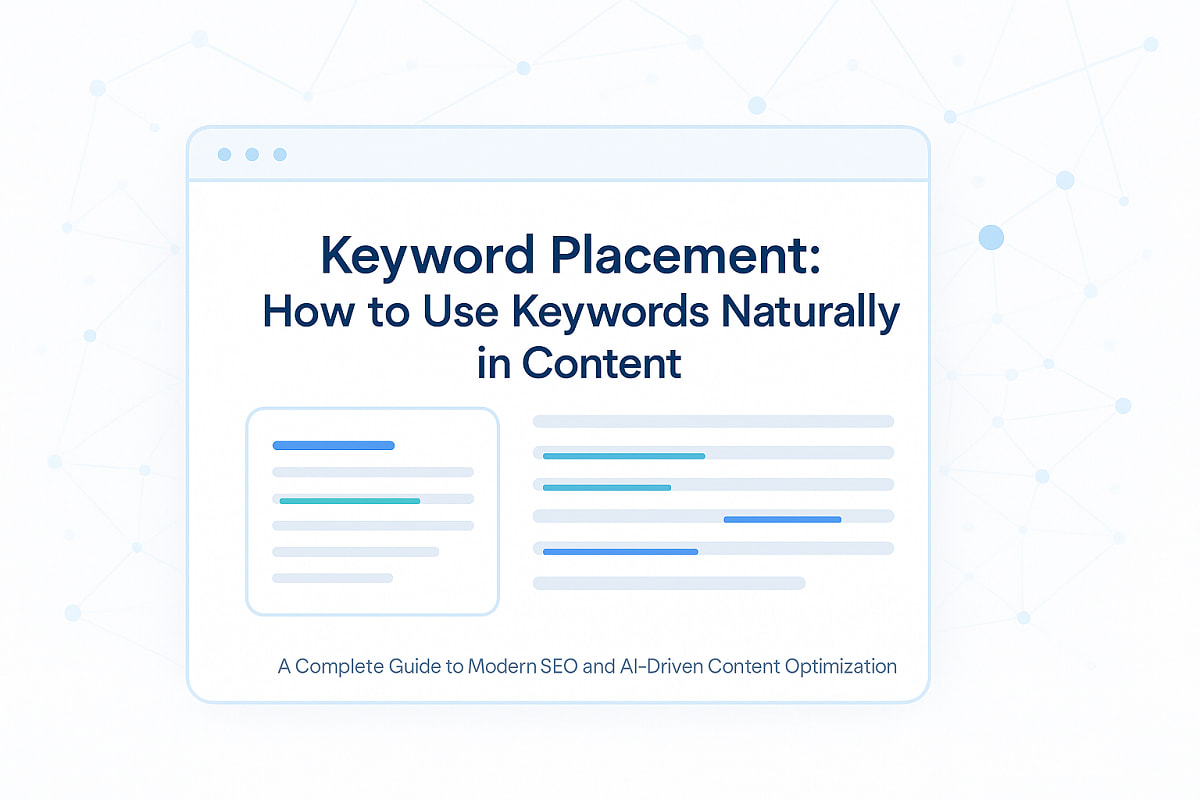
How Search Engines and AI Models Interpret Keywords Today
Search has moved from pattern recognition to meaning comprehension. Google’s BERT, MUM, and Gemini, along with AI engines like Perplexity or ChatGPT Search, analyze not just words but relationships.
When Google reads a page, it interprets entities (people, tools, brands, concepts) and how they connect. It asks:
- What topic is this content about?
- What intent does it satisfy?
- Which entities reinforce its meaning?
- How does it fit into broader knowledge graphs?
AI systems use embeddings, which are mathematical representations of meaning, to understand that “keyword placement,” “keyword usage,” and “on-page keyword strategy” all express similar ideas. This is why you don’t need exact-match repetition anymore; you need semantic breadth.
For example, an article about “using keywords naturally” might include contextual phrases like “content optimization,” “search intent,” and “semantic search signals.” These related entities help both Google and generative AI tools classify your page as authoritative in that domain.
When your keywords are positioned naturally in titles, headings, and semantically rich contexts they signal not only relevance but also expertise.
Core Principles of Natural Keyword Placement
Natural keyword placement is about coherence. The goal is to make the keyword serve the content, not the other way around. Readers should never feel that a word was “inserted” for SEO’s sake.
Here are a few guiding principles:
- Relevance over frequency.
Focus on maintaining topic integrity. Use your target keyword when it genuinely fits the context of your paragraph. - Readability first.
A keyword that disrupts sentence flow diminishes both user experience and ranking potential. Search engines prioritize engagement signals, if readers bounce, optimization fails. - Variation and semantic expansion.
Use synonyms, related entities, and natural variations. For instance, if your keyword is “on-page SEO,” mix in “content optimization,” “metadata improvements,” and “HTML tags.” - The Three Rs of Natural Placement:
- Relevance: Every keyword must fit the topic.
- Readability: The text must sound natural when read aloud.
- Rhythm: The keyword should blend with sentence rhythm and pacing.
Search engines reward content that sounds human because it is written for humans. Consistent, organic phrasing creates the kind of natural tone AI models increasingly favor when ranking or citing sources.
Strategic Keyword Positions That Still Influence Rankings
While AI-driven search is more context-aware, certain keyword placements still hold strategic importance. The way you position your keywords shapes how your content is indexed, summarized, and presented in both traditional and AI search results.
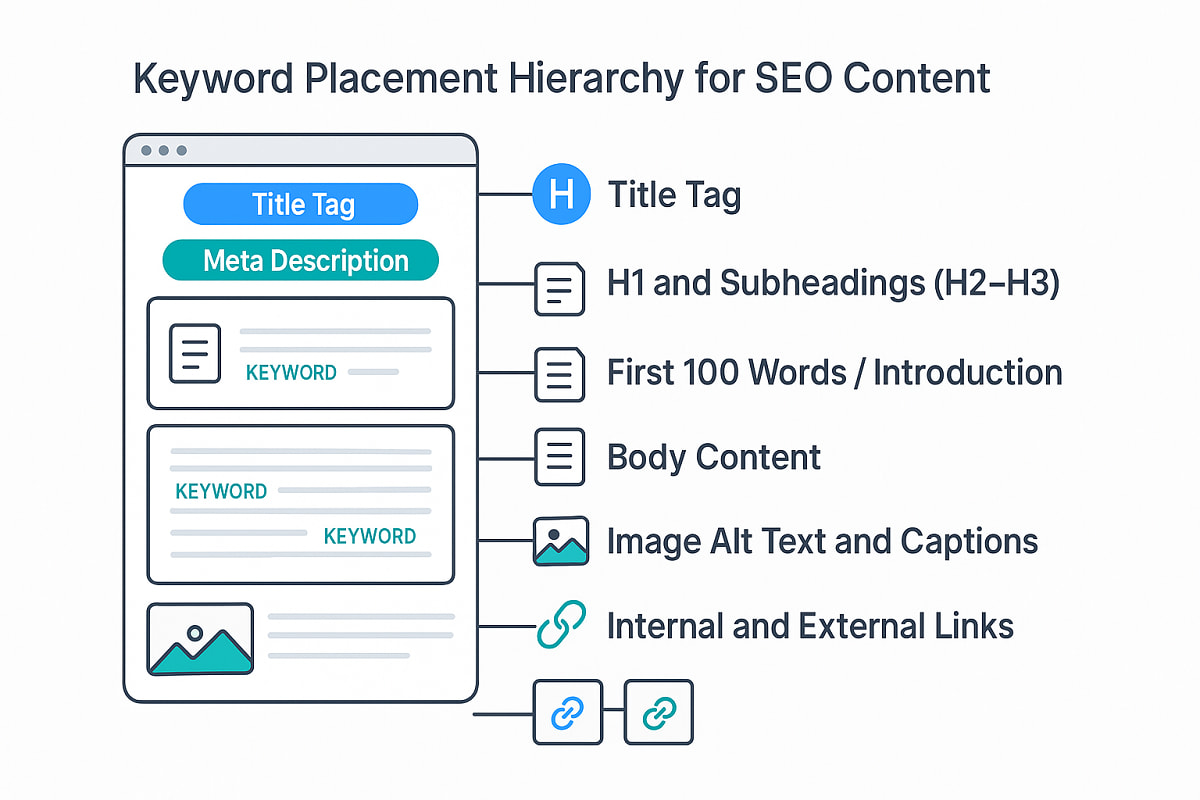
Title Tag and Meta Description
The title tag remains one of the strongest on-page signals for both Google and AI-generated summaries. Your primary keyword should appear once, naturally woven into a clear, compelling phrase. For example:
“Keyword Placement Strategies: How to Use Keywords Naturally in Content”
Avoid redundancy, don’t repeat the same phrase in the meta description. Instead, use related terms that support the same intent. A good meta description should summarize the article’s value rather than stuff in keywords.
Meta descriptions also serve a new purpose: they influence how AI and search engines describe your page in previews. Writing them with natural keyword phrasing ensures better contextual alignment across platforms.
Headings (H1–H3)
Headings create structure, clarity, and scannability. Including your main keyword or a variation in the H1 is essential, but it should sound like a natural title, not a label.
Subheadings (H2–H3) can feature secondary or long-tail keywords, but again, balance is key. The goal is to give both readers and search crawlers a map of what each section covers. For example:
- H1: Keyword Placement: How to Use Keywords Naturally in Content
- H2: Understanding Modern Keyword Intent and Context
- H3: Core Principles of Natural Keyword Integration
Each heading tells both humans and algorithms what to expect, enhancing navigability and contextual depth.
First 100 Words and Introduction
Search engines give extra weight to early mentions of key phrases. Including your primary keyword within the first 100 words helps establish topical relevance.
However, the trick is to use it organically. Instead of forcing it into the opening line, craft an introductory paragraph where the keyword appears as part of a logical statement. For example:
“Keyword placement plays a defining role in how search engines interpret content and how readers engage with it.”
That’s natural, not mechanical. It sets tone and context simultaneously.
Throughout the Body Content
The body of your content is where keyword integration truly unfolds. Keywords should appear only when they fit the reader’s expectations. If a section discusses semantic SEO, for instance, that’s an appropriate place to mention related keywords, not to meet a frequency goal but to reinforce meaning.
One effective approach is to use co-occurrence patterns by naturally associating your target term with related entities and verbs. For example, if the keyword is “keyword placement,” use phrases like “optimize keyword usage,” “strategically position terms,” or “balance semantic signals.”
This variation strengthens your topical authority and prevents your writing from sounding repetitive or algorithmic.
Image Alt Text and Captions
Images provide an underrated opportunity for keyword integration. Alt text serves two purposes; accessibility for visually impaired users and semantic context for search crawlers.
Alt descriptions should describe the image naturally while embedding relevant terms. For example:
“Screenshot showing keyword placement in an optimized blog post structure.”
Captions can occasionally include secondary keywords, but only if they add real explanatory value. Avoid turning every image into a keyword vehicle; relevance should dictate usage.
Internal and External Links
Internal linking is a subtle but powerful placement strategy. When linking to another page, use descriptive anchor text that naturally includes a keyword variation. For example:
“For a deeper dive, read our guide on [on-page SEO best practices].”
This connects related topics without over-optimization. Similarly, external links should use contextual anchors that enhance reader trust and topical relationships.
Keywords within links serve as semantic bridges across your content ecosystem, helping search engines interpret the structure and depth of your site.
Writing Naturally: The Art of Seamless Keyword Integration
Writing naturally while optimizing for keywords is both a craft and a discipline. The best writers don’t think about inserting keywords, they think about communicating clearly and meaningfully. The keywords simply belong because the content’s logic, intent, and topic demand them.
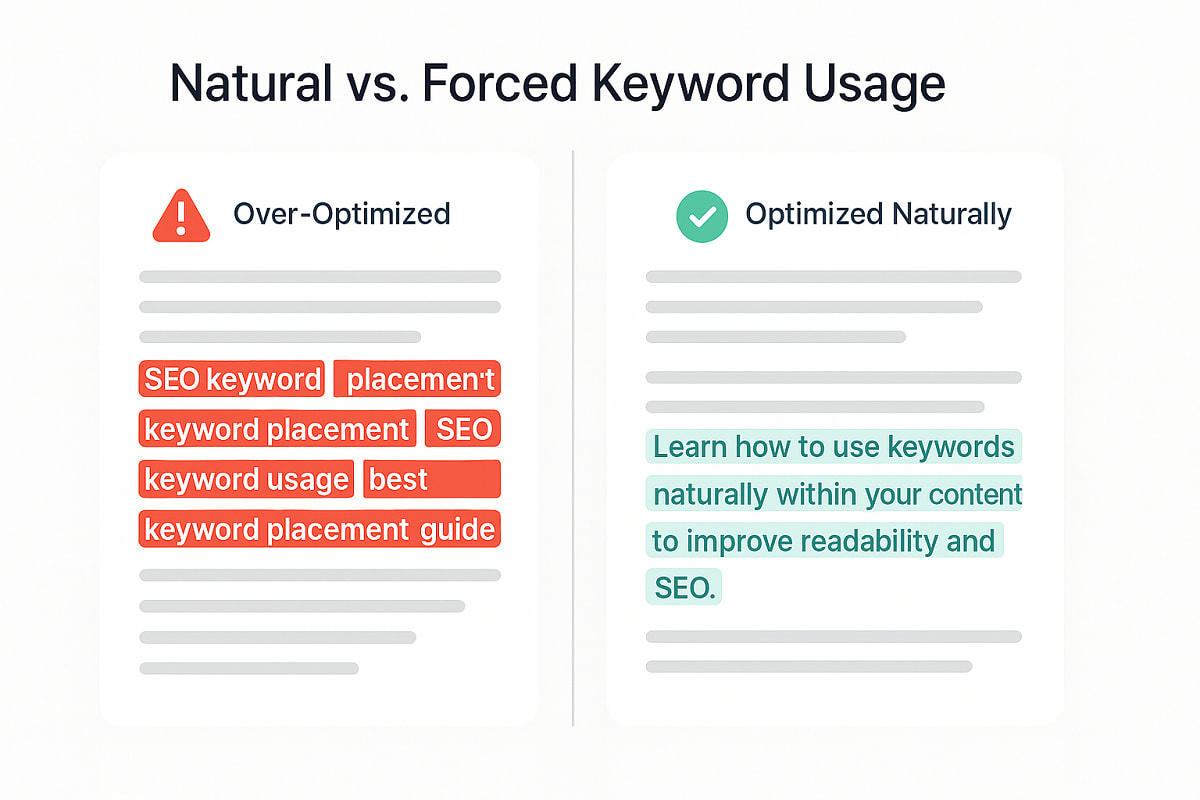
Natural keyword integration starts with intent-driven writing. Before drafting, define what problem your article solves, who it’s for, and what language your audience uses. Once that’s clear, you won’t have to force keywords; they’ll surface organically as part of the conversation.
An effective exercise is to read your content aloud. If a sentence feels unnatural or stilted when you hit the keyword, that’s a red flag. Instead of forcing phrasing like “Keyword placement is important for SEO ranking improvement,” rewrite it to sound conversational:
“How you place your keywords directly affects how search engines interpret your page.”
A second approach is thematic layering, repeating the idea rather than the phrase. Use related expressions like “keyword usage,” “content optimization,” or “semantic relevance.” This builds linguistic variety and keeps your writing fluid.
When writing for both human readers and AI engines, remember that rhythm and readability often matter more than frequency. Natural keyword integration is about the reader’s experience first, and SEO as the outcome, not the objective.
Balancing Keywords with Semantic Relevance and Entities
In modern SEO, a keyword rarely stands alone. Every phrase you use connects to a broader web of entities; people, products, brands, and concepts that define meaning in search. Search engines no longer rely solely on keywords but on the relationships between them.
For instance, the keyword “keyword placement” connects naturally to entities such as “on-page SEO,” “Google algorithms,” “semantic search,” and “content optimization.” Mentioning these related ideas strengthens your topical authority and signals to search engines that your content is comprehensive.
This is known as entity optimization, the practice of including conceptually related terms and attributes that clarify meaning for both users and AI systems. You don’t need to list them artificially; they should arise naturally from your explanation of the topic.
Consider how humans process meaning. When someone says “SEO content strategy,” your brain doesn’t isolate the term “SEO.” It connects it with “keywords,” “rankings,” “search intent,” and “optimization.” Search algorithms now mimic that same associative logic.
You can apply this by:
- Using contextually related phrases rather than repeating the same keyword.
- Including entities and attributes that explain the main keyword’s role (e.g., “keyword intent,” “content mapping,” “semantic variations”).
- Writing with topical depth; adding background, examples, and connected ideas rather than overusing the target term.
When entities are well-represented, your page becomes easier for AI systems to understand, cite, and summarize. It’s how you move from keyword-level optimization to concept-level authority, the currency of modern SEO and AI discovery.
Keyword Density: Does It Still Matter in the AI Search Era?
Keyword density once dominated SEO playbooks. Marketers chased percentages i.e. 2%, 3%, 5% etc. believing the right number could unlock higher rankings. That era has ended.
Today, algorithms evaluate meaning coverage, not frequency. AI-driven systems like Gemini, ChatGPT Search, and Google’s MUM model assess how completely a piece of content explains a topic. Repeating a term doesn’t strengthen a page; expanding its context does.
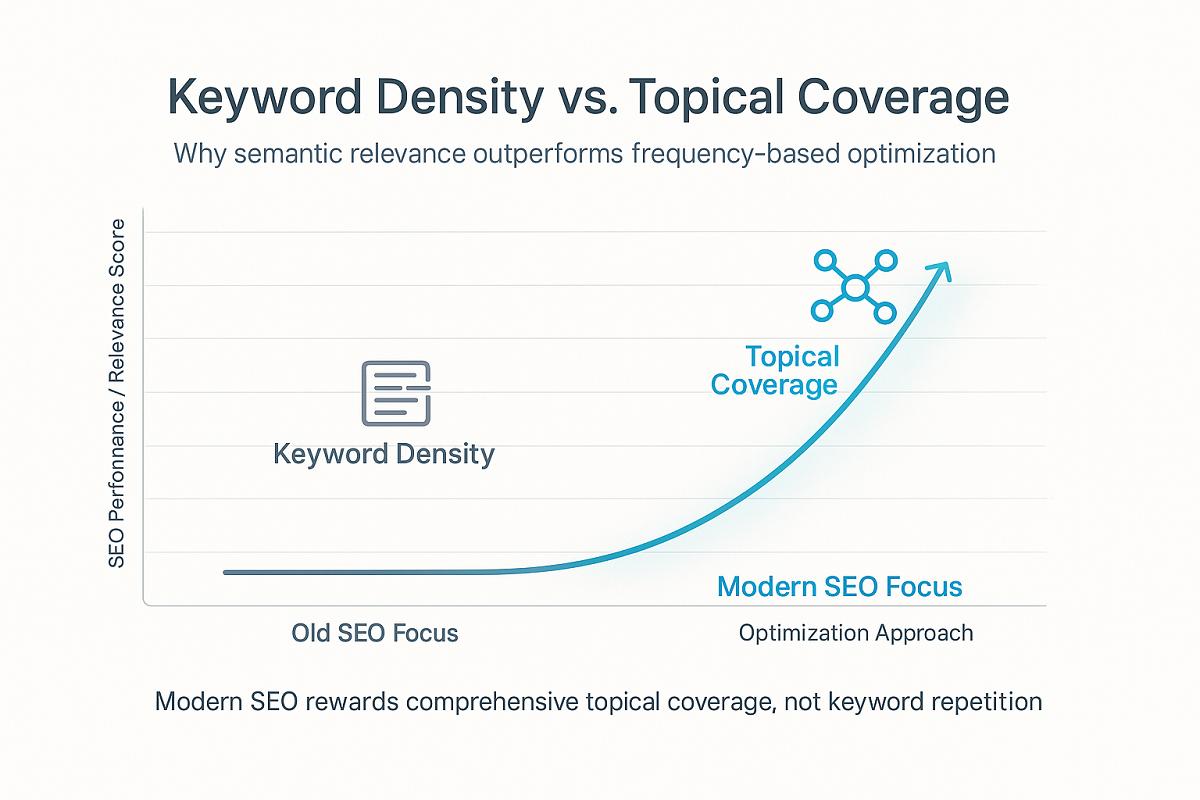
A good mental model is density through diversity, meaning your keyword appears naturally across sections, supported by semantically related terms. The goal isn’t to hit a percentage but to achieve linguistic completeness.
If you still want a guideline, think of keyword density as a signal, not a metric. Using your target keyword two or three times per thousand words, if it fits organically, is sufficient. Beyond that, your focus should be on contextual expansion.
The real ranking strength now lies in:
- Topic coverage: How thoroughly you explain the subject.
- Semantic variety: How you use related phrases, synonyms, and concepts.
- Entity connections: How clearly your content ties to real-world subjects.
When you write for meaning, density takes care of itself. AI and search engines recognize conceptual richness and reward it over mechanical repetition.
Contextual Optimization: Matching Keywords with Search Intent
The success of keyword placement depends not only on where you put your terms but why. Each placement should serve the underlying intent behind a user’s query.
Contextual optimization is the practice of aligning your keyword usage with the reader’s goals and expectations. For instance, a user searching “how to use keywords naturally” is seeking a tutorial-style explanation, not a sales pitch. If your page mirrors that intent by offering practical steps, examples, and reasoning, your keywords will feel authentic.
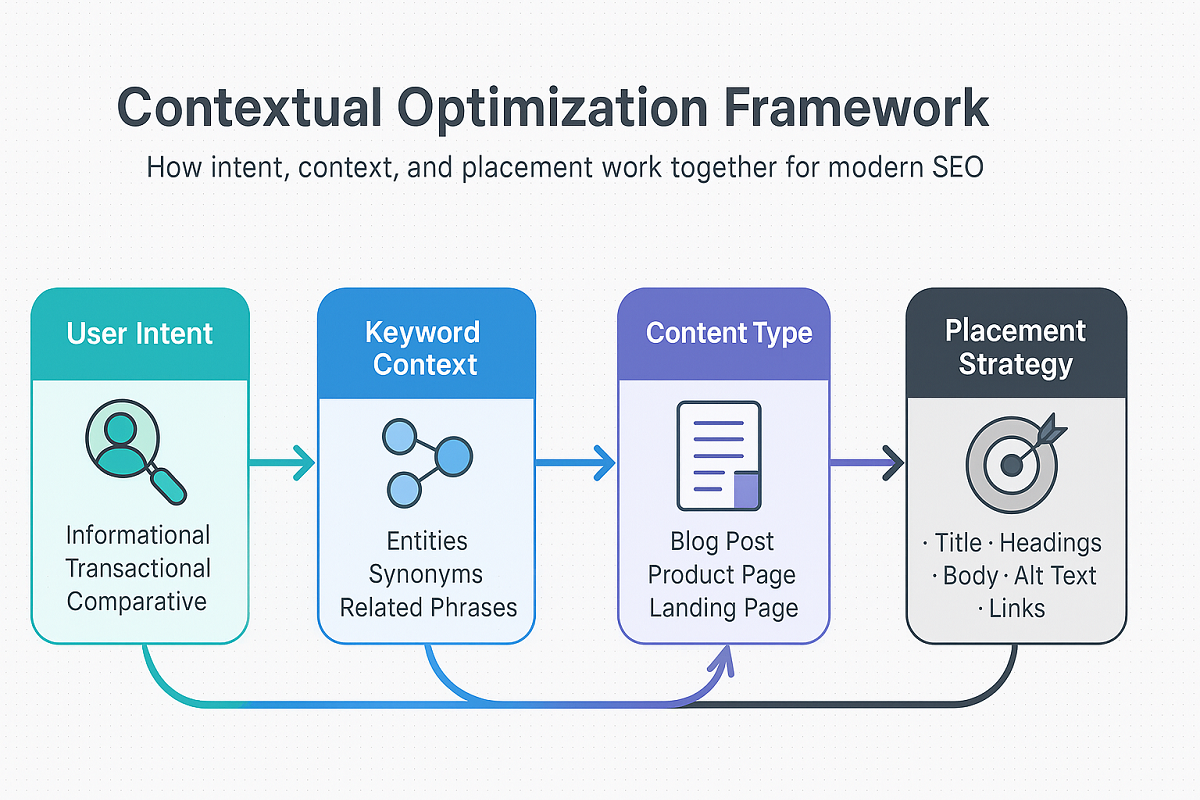
The key lies in intent-matched phrasing. Instead of repeating the keyword, express it in ways that reflect the query’s purpose:
- “How to write with SEO keywords naturally”
- “Tips for organic keyword placement”
- “Making keyword usage sound natural in long-form content”
ariation maintains the same core meaning but caters to different linguistic preferences. This variety improves both human engagement and AI interpretation.
Another layer of contextual optimization involves query anticipation, predicting related questions users might ask. By addressing those naturally in your content, you expand topical depth. For example, in an article about keyword placement, covering “keyword density” or “entity optimization” anticipates natural follow-ups and reinforces contextual coverage.
Modern SEO is increasingly intent-centric. When your keywords flow from that understanding, your content remains both user-focused and search-friendly.
Advanced Strategies for AI SEO and Generative Engines
Search is rapidly evolving beyond static results. Generative engines like ChatGPT, Perplexity, Google Gemini, and Claude synthesize information from multiple sources to create dynamic, conversational answers. Keyword placement in this context isn’t about ranking alone, it’s about being understood and cited by AI systems.
Let’s look at how to adapt keyword strategies for this new paradigm.
Optimizing for Conversational and Entity-Based Queries
Generative engines interpret questions as conversations. They prioritize clarity, completeness, and contextual accuracy. When writing content, use naturally conversational phrasing that matches how users speak, not just how they search.
For instance:
Instead of: “Keyword placement SEO tips,”
Write: “Here’s how to use keywords naturally to improve your on-page SEO.”
This phrasing reflects how people naturally speak when interacting with AI search systems. It also introduces related entities (“on-page SEO”) that help AI models connect the dots between your topic and broader knowledge graphs.
Additionally, including short, well-structured sections with concise summaries makes your content easier for AI to parse and quote in generated answers.
Creating Content That Feeds AI Summaries
AI systems often extract sentences or structured snippets directly from content to form summaries. To make your page “AI-friendly,” structure your paragraphs logically, one main idea per section, with supporting details.
Include clear definitions, lists where appropriate, and short sentences summarizing insights. For instance:
“Natural keyword placement means using keywords in ways that sound human, contextually relevant, and semantically rich.”
This kind of declarative statement doubles as a summary-ready sentence. When AI models crawl and evaluate your content, such phrasing increases the likelihood that your material will appear in AI-generated answers or snippets.
Structuring Keywords for GEO and AEO Compatibility
Generative Engine Optimization (GEO) and Answer Engine Optimization (AEO) extend traditional SEO principles to AI environments. In these systems, keyword placement contributes to context clarity rather than direct ranking.
Here’s how to adapt:
- Use entities consistently. Mention products, tools, or people by name (e.g., “DefiniteSEO’s on-page analyzer”) to anchor your content in factual reality.
- Organize logically. AI models favor content with predictable hierarchy; clear headings, definitions, and conclusions.
- Include context in your phrasing. Instead of “keyword placement,” say “keyword placement in long-form content” or “keyword placement for SEO copywriting.”
By extending your keyword phrases naturally, you make your content compatible with both human readers and machine interpreters.
In the era of AI-driven search, keyword placement has evolved into meaning placement, the art of situating concepts in a way that both people and algorithms find useful.
Common Keyword Placement Mistakes to Avoid
Even seasoned content creators occasionally fall into keyword traps. These mistakes are rarely about intent, they’re about balance. Over time, many writers adopt outdated habits or follow simplistic SEO rules that no longer reflect how search engines evaluate language and meaning.
One of the most common errors is keyword stuffing; forcing the same term into every paragraph to satisfy an arbitrary “density” target. This not only harms readability but also sends spam-like signals to modern algorithms trained to detect unnatural repetition. Readers disengage quickly, and engagement metrics drop as a result.
Another recurring mistake is ignoring context. Writers sometimes insert keywords without considering whether they fit the surrounding narrative. For example, dropping “SEO keyword placement” in a sentence about design layout creates semantic confusion. Search engines interpret that as incoherence, reducing topical clarity.
A subtler problem is over-optimized anchor text in internal links. Linking repeatedly with the same exact keyword phrase can trigger over-optimization penalties and looks manipulative. Instead, vary your anchor text naturally, use phrases like “learn about on-page optimization” or “understand keyword integration best practices.”
Other pitfalls include:
- Using unnatural plural forms or exact matches where they don’t fit.
- Neglecting semantic variations that make writing more human.
- Writing for bots first, assuming readers will adapt.
The essence of keyword placement lies in balance, an equal respect for human comprehension and machine interpretation. If your writing feels fluent and valuable to a person, it will almost always perform well algorithmically.
Tools and Techniques for Smarter Keyword Integration
Technology can enhance intuition when it comes to keyword strategy, especially when used intelligently. Rather than relying solely on keyword frequency tools, modern SEOs leverage platforms that understand semantics, intent, and content structure.
A practical workflow starts with keyword mapping; aligning each keyword with a specific intent and page type. Before writing, identify which keyword best fits the informational, transactional, or comparative stage of your topic. This helps prevent overlap and redundancy across your site.
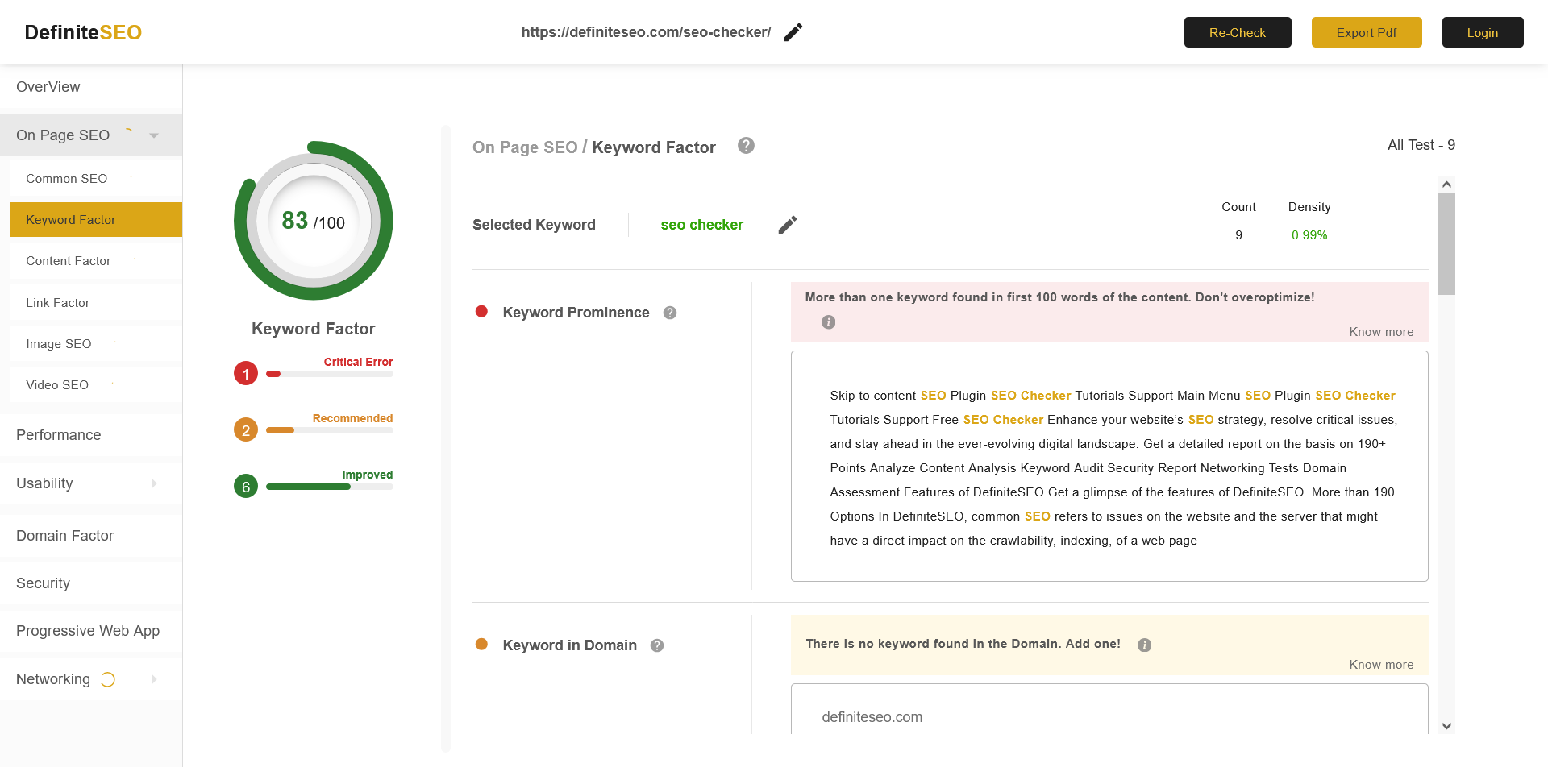
Tools like DefiniteSEO’s On-Page Analyzer can automatically highlight keyword usage, suggest placement improvements, and detect semantic gaps. For instance, it may show whether your primary term appears naturally in headings, metadata, and introductory paragraphs without encouraging overuse.
Complementary tools include:
- Google NLP API: to evaluate entity associations and sentiment relevance.
- SurferSEO or Clearscope: to gauge semantic completeness by comparing your content with top-ranking results.
- Ahrefs or Semrush: for keyword clustering and co-occurrence analysis.
Beyond tools, writers should adopt content layering, it is building sections around keyword families instead of single phrases. This technique ensures topical depth and allows natural integration of variations like “keyword usage,” “content optimization,” or “semantic SEO.”
In the long term, the smartest strategy isn’t automating keyword placement but using technology to enhance your editorial instincts. Tools should guide your awareness, not dictate your language.
Real-World Examples and Practical Applications
To illustrate how natural keyword placement works in practice, let’s examine three real-world scenarios, each representing a different type of content where keyword strategy plays a distinct role.
Example 1: Blog Post on “On-Page SEO”
A typical blog post might target the keyword “on-page SEO checklist.”
Instead of repeating it five times in the introduction, the writer uses variations like “optimize your website structure” and “improve on-page elements.” The keyword appears once in the title, once in the introduction, and once in a subheading. Throughout the article, the focus shifts to semantically related entities; meta tags, internal links, keyword intent, and content depth.
This creates a natural reading flow while maintaining relevance for search engines.
Example 2: Product Page for an SEO Tool
For a product targeting “WordPress SEO plugin,” the keyword appears strategically:
- In the H1: WordPress SEO Plugin for Smarter Optimization
- In the opening paragraph as part of a complete thought.
- In one image alt tag describing the interface.
- Once in the CTA: Download our WordPress SEO Plugin today.
Rather than repeating the term mechanically, the content includes supporting phrases like “optimize metadata,” “content scoring,” and “on-page analysis.” This combination of semantic signals strengthens ranking potential without overuse.
Example 3: Educational Resource
An in-depth guide targeting “how to use keywords naturally” may use that phrase two or three times throughout the piece. The remainder of the content relies on semantic alignment, discussing keyword density, entity optimization, and context-based phrasing.
The result is content that reads naturally but still ranks because it covers the entire concept space surrounding the keyword.
These examples demonstrate a core truth: natural placement emerges from purpose and clarity, not formula. Writers who prioritize structure, context, and entity coverage naturally produce SEO-strong content without deliberate manipulation.
Final Thoughts: From Keywords to Concepts
Keyword placement began as a mechanical process i.e counting words, checking densities, and adhering to templates. Today, it has become a creative, strategic, and almost linguistic art form. The most successful SEO professionals understand that keywords are only the surface of meaning; beneath them lies intent, context, and the vast network of entities that define relevance.
As we transition into the era of AI-driven search, the distinction between optimizing for algorithms and optimizing for users is dissolving. Search engines are evolving to think more like humans, interpreting nuance, tone, and relationships. This shift demands content that reflects genuine understanding rather than keyword manipulation.
The next stage of optimization i.e. AEO (Answer Engine Optimization) and GEO (Generative Engine Optimization) will rely less on surface-level keywords and more on contextual precision. That means writers must focus on conceptual coherence: ensuring every keyword fits naturally within an authentic narrative supported by factual entities and meaningful language.
Ultimately, good keyword placement is about trust between writer and reader, between content and machine. It’s what allows a paragraph to resonate with a human and register with an algorithm simultaneously. When your content flows, informs, and aligns with real intent, the keyword finds its rightful place naturally, effortlessly, and effectively.
Frequently Asked Questions
How many times should I use a keyword in a 1500-word article?
There’s no fixed number anymore. Modern search algorithms evaluate meaning and context, not frequency. If your keyword fits naturally two to three times across a 1500-word piece, once in the title, once early in the introduction, and once in the body that’s usually enough. What matters more is whether your article thoroughly covers the topic, uses semantic variations, and stays aligned with user intent.
Should I still include keywords in image alt text?
Yes, but only when it fits naturally with the image description. Alt text exists to improve accessibility, so your priority should be clarity. For instance, instead of “keyword placement infographic,” write “illustration showing natural keyword placement in content.” This way, you help both visually impaired readers and search engines understand the context.
How do I make my keyword placement sound natural?
The easiest method is to write first, optimize later. Draft your content in your natural tone, then review it for opportunities to integrate your target terms smoothly. Read sentences aloud, if the keyword feels forced, rephrase it. Using variations, pronouns, and semantically related terms makes the placement seamless.
What’s the best way to optimize for AI-generated answers?
Structure your content logically with short, self-contained explanations. Use concise statements that summarize main ideas clearly, since AI models often quote or paraphrase such lines when generating summaries. Also, include clear headings and related entities so the AI can interpret and connect your content contextually.
Are LSI keywords still useful in 2025?
The concept of LSI (Latent Semantic Indexing) is outdated, but its principle remains valid. Search engines don’t use literal LSI anymore, but they rely heavily on semantic relationships. Using related words, entities, and contextual phrases helps AI models understand meaning, which functions similarly to how LSI once worked.
Can keyword placement affect how AI tools like Gemini, ChatGPT or Perplexity interpret my page?
Yes, indirectly. Generative engines use semantic parsing to identify entities and meaning relationships. Well-placed keywords, especially in headings, introductions, and summaries make your content easier to parse and quote. The clearer your structure and context, the more likely your page will appear in AI-generated summaries.
Is there a difference between keyword placement for blogs and product pages?
Yes, the intent differs. Blog posts use keywords to educate, so placement focuses on natural flow, context, and headings. Product pages use keywords to clarify value and functionality, so they should appear in titles, meta tags, CTAs, and key descriptions. Both follow the same principle: use the keyword where it enhances understanding, not where it distracts.